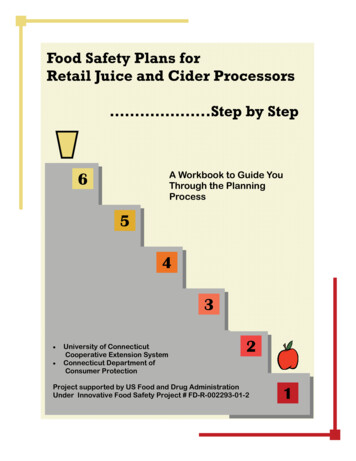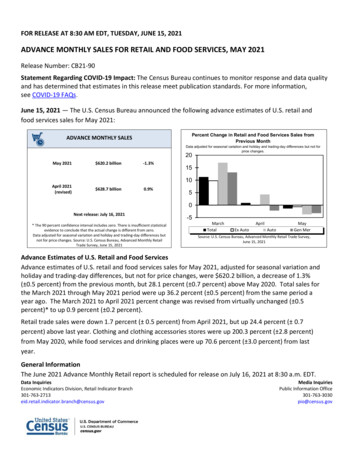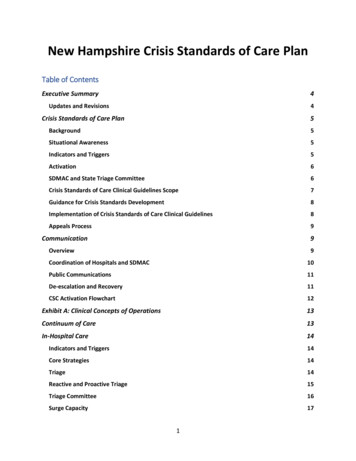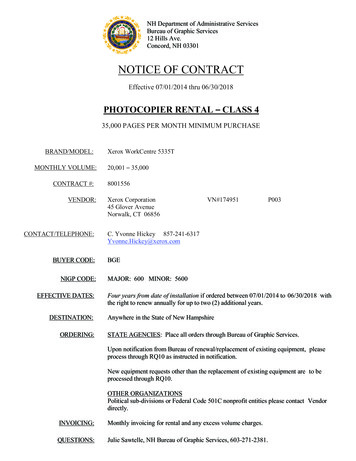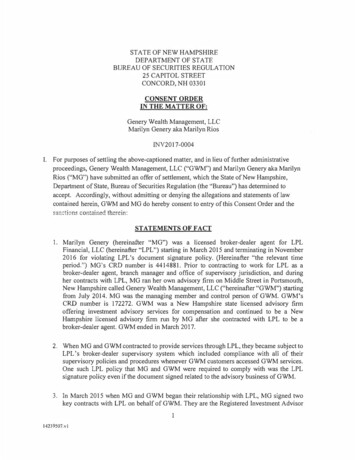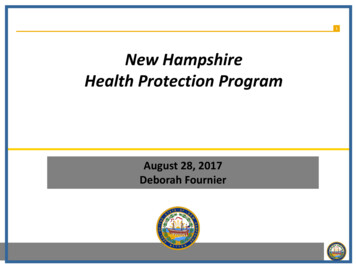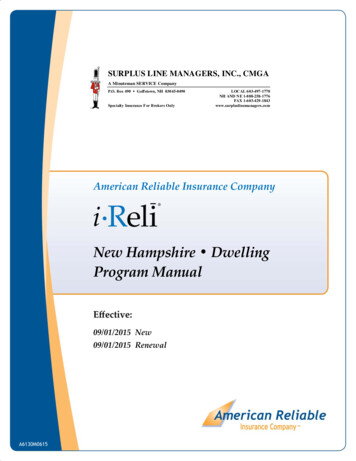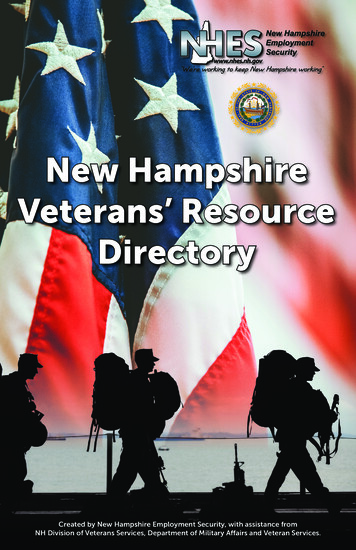
Transcription
Emergency Action PlanforRetail Food EstablishmentsNew Hampshire Department of Health and Human ServicesDivision of Public Health ServicesFood Protection Section29 Hazen DriveConcord, NH 03301603-271-4589, foodprotection@dhhs.state.nh.us
NEW HAMPSHIRE DEPARTMENT OF HEALTH AND HUMAN SERVICESEmergency Action Plans For Retail FoodEstablishmentsPractical Guidance for Retail Grocery and Food Service Establishmentsto Plan and Respond to Emergenciesthat Create the Potential for an Imminent Public Health ThreatNH Division of Public Health ServicesFood Protection Section29 Hazen DriveConcord, NH 03301603-271-4589FAX www.dhhs.nh.gov/DHHS/FOODPROTECTIONAfter hour contact number: 1-800-852-3345 ext. 5300Acknowledgement: This document was excerpted from the Emergency Action Plans for Retail FoodEstablishments produced by the Detroit Department of Health and Wellness Promotion, Macomb CountyHealth Department, Michigan Department of Agriculture, Michigan Restaurant Association, the OaklandCounty Health Department, and Emergency Preparedness Committee of Council II 2004-2006 Conference forFood Protection1NH Division of Public Health Services, Food Protection Section2007
NEW HAMPSHIRE DEPARTMENT OF HEALTH AND HUMAN SERVICESEmergency Action Plan for Retail Food EstablishmentsTable of ContentsPageIntroduction3Responsibilities of the Licensee and RegulatoryAuthority During an Emergency7Emergency Action PlanInterruption of Electrical Service8Interruption of Water Services13Contaminated Water Supply (Biological)17Sewage Backup21Fire27Flood31Employees with Gastrointestinal Illness36References38Emergency Contact Information392NH Division of Public Health Services, Food Protection Section2007
NEW HAMPSHIRE DEPARTMENT OF HEALTH AND HUMAN SERVICESIntroductionPlanning AheadIt is important to plan ahead and be prepared for any emergency situation that couldaffect your food service establishment. You should consider the type of hazard(s) forwhich your establishment is most vulnerable and take precautions to minimize the impactof such occurrences.For example, of the imminent health hazards listed in this document, statistics show thatinterruption of electrical service is likely to be the most common. Ask yourself whatwould you do if your establishment lost power today? What would you do if the poweroutage lasts for an extended period of time, is widespread, and many people arecompeting for ice, batteries, generators, water, refrigerated trucks, etc? Would yourbusiness survive?According to the National Archives and Records Administration: Only 43% of companies struck by disaster resume operations29% of those that resume business fail within two yearsThe high cost of paying staff who are idle, cost associated with loss of staff, added workand material costs related to the disaster, loss of inventory, other hard cash costs, lostbusiness, lost customer loyalty, and lost customer confidence all take a toll.The following checklist is intended to help you start the planning process:Water Supply Related IssuesPrepare an “emergency menu” in advance including recipes for food items thatrequire no water or minimal amounts of water to prepare.Maintain an inventory of single-service and single-use articles to help get througha reasonable time period.Maintain an inventory of bottled water.Maintain an inventory of containers suitable for hauling water.Maintain an inventory of disposable gloves and hand sanitizer.Develop a business agreement with a supplier of bottled water or water hauler thatwill provide assurance that you will have an alternative source of water availableduring an emergency.Locate public water supplies in your area and points where containers can befilled with drinking water.Develop a contingency plan for toilets. If the water service is interrupted, wherewill you and your employees find toilet facilities available for use?3NH Division of Public Health Services, Food Protection Section2007
NEW HAMPSHIRE DEPARTMENT OF HEALTH AND HUMAN SERVICESDevelop a business agreement with a supplier of ice in order to assure you willhave access to ice during an emergency.Maintain contact information for people who can help you, such as your plumber,water well drilling contractor, utility company, ice supplier, water supplier,provider of portable toilets, local health officer, Division of Public HealthServices Food Protection Section, emergency broadcast station frequencynumbers, etc.Develop a list of equipment that uses water in your establishment and develop acontingency plan that describes what you would do if the water is eitherinterrupted or contaminated. Use the Emergency Action Plans as a guide to helpdescribe the steps that you would take in your own establishment.Interruption of Electrical ServicePower outages are the most frequent type of man-made disasters. Statisticsindicate that the average power outage lasts four hours. The August 2003 poweroutage disaster affecting large areas in the northeast part of the country lasted fourdays.Consider access to a generator to be used in emergencies. Make certain that thegenerator has the capacity to operate critical pieces of equipment such asrefrigeration and freezer units, pumps, safety lighting, hot water heaters, etc.Make certain that individuals are trained to operate the equipment safely. Informthe utility company that you are using a generator as a safety precaution for theiremployees. Make certain there is proper ventilation to avoid carbon monoxidepoisoning.Consider securing access to a refrigerated truck that can be delivered to the siteduring an emergency.Consider securing access to a refrigerated warehouse that has a back-up generatorto which you can bring food needing refrigeration in insulated containers.Prepare an “emergency menu” in advance including recipes for food items that donot require cooking since the ventilation system will no longer remove smoke,steam, grease-laden air, etc.Develop a plan for minimizing loss of food product held under refrigeration.Opening refrigeration equipment doors will cause the food to warm more quickly.Use tape and/or cardboard to insulate refrigeration units to retain coldtemperatures. What is your strategy for loss prevention?If you plan to use ice to keep food cold, where will you obtain ice when ice is inhigh demand by the general population?Dry ice should not be used in enclosed spaces (i.e. walk-in cooler) because of thepotential build-up of carbon dioxide.Heating, air conditioning, security systems, computers, cash registers, lighting andother systems may not operate. Develop a plan for coping with these problems.Maintain contact information for people who can help you such as the utilitycompany, garbage hauling service, ice supplier, refrigerated truck company, foodwarehouse, septic tank pumping service, local health officer, NH Division of4NH Division of Public Health Services, Food Protection Section2007
NEW HAMPSHIRE DEPARTMENT OF HEALTH AND HUMAN SERVICESPublic Health Services (NHDPHS) Food Protection Section, emergency broadcaststation frequency numbers, etc.Develop a list of equipment that uses electricity in your establishment anddevelop a contingency plan that describes what you would do if electrical serviceis interrupted. Use the Emergency Action Plans as a guide to help describe thesteps that you would take in your own establishment.Sewage Back UpDevelop a list of equipment and facilities that have a drain. What specific stepswould you take if each piece of equipment or a combination were no longeroperable due to a drainage problem? Use the Emergency Action Plans as a guideto help describe the steps that you would take in your own establishment.Develop a contingency plan for toilets. If the drain no longer functions, wherewill you and your employees find toilet facilities available for use?Have a procedure for appropriate cleaning and sanitization after sewage back up.Maintain contact information for people who can help you, such as the plumber,drain cleaning service, professional cleaning service, utility company, septic tankpumping service, local health officer, NHDPHS Food Protection Section, etc.In Case of FirePost the phone number of the fire department in a conspicuous place by eachphone.Ask the local fire marshal or other authority to conduct an assessment todetermine if there are any fire hazards.Develop a plan for what to do in case of fire.Assure your fire extinguisher is charged and hood inspections are up to date.Maintain contact information for people who can help you such as the firedepartment, police department, insurance company, water and fire damagerestoration company, utility companies, lawyer, local health officer, Division ofPublic Health Services Food Protection Section, etc.In Case of FloodDetermine if food and other products that can be damaged by water are beingstored in areas prone to flooding, are a minimum of 6 inches off of the floor, arenot under water and/or sewer lines, etc.Develop a plan for monitoring and maintaining sump pumps, down spouts,plumbing, exterior surface grading, storm drains, and other facilities that cancontribute to flooding.Maintain contact information for people who can help you such as the plumber,electrician, local rent-all store, fire department, police department, insurance5NH Division of Public Health Services, Food Protection Section2007
NEW HAMPSHIRE DEPARTMENT OF HEALTH AND HUMAN SERVICEScompany, water damage restoration company, utility companies, local healthofficer, NHDPHS Food Protection Section.CommunicationDevelop a plan for communicating with key people in your organization.Keep a list of emergency contact numbers with you at all times.6NH Division of Public Health Services, Food Protection Section2007
NEW HAMPSHIRE DEPARTMENT OF HEALTH AND HUMAN SERVICESResponsibilities of the Licensee and Regulatory Authority During anEmergencyLicensee: For an isolated event:In the event of an imminent health hazard involving interruption of electrical service,interruption of water service, contaminated water supply, fire, flood, or sewage back upat an individual establishment, the licensee shall:1. Assess the situation.2. Immediately discontinue operation if a safe operation cannot be maintained using analternative procedure.3. Notify the NHDPHS Food Protection Section of the imminent health hazard anddiscuss alternative procedures to be used. Determine if the issue is widespread.4. Remain closed until granted approval to re-open by the NHDPHS Food ProtectionSection5. Follow the appropriate Emergency Action Plan if directed to do so by the NHDPHSFood Protection Section or other regulatory authority.Licensee: For a widespread emergency:In the event of an imminent health hazard involving interruption of electrical service,interruption of water service, contaminated water supply, fire, flood, or sewage back upthat affects numerous establishments, the licensee shall:1. Conduct an evaluation of the operation as it relates to the hazard to determine if a safeoperation can be maintained in accordance with He-P 2300, the NH Rules for theSanitary Production and Distribution of Food.2. Close the establishment if a safe operation cannot be assured.3. If a safe operation can be assured, the establishment can remain open provided theappropriate Emergency Action Plan is followed.NHDPHS Food Protection SectionThe NHDPHS Food Protection Section will:1. Respond to isolated events involving imminent health hazards and provide guidanceto help the licensee resume operation as quickly as possible.2. Allow licensees to assess food safety within their individual establishment during awidespread emergency and allow the licensee to follow the Emergency Action Plan.3. Communicate with the industry during widespread emergencies through mass media,hot lines, web sites, etc.4. Conduct surveillance during a widespread emergency to determine if licensees arefollowing Emergency Action Plans.5. Conduct enforcement activity as appropriate to protect public health.7NH Division of Public Health Services, Food Protection Section2007
NEW HAMPSHIRE DEPARTMENT OF HEALTH AND HUMAN SERVICESEmergency Action PlanInterruption of Electrical ServiceFor the purpose of defining an imminent health hazard for this Emergency Action Plan(EAP), an extended interruption of electrical service means that the electrical service hasbeen interrupted for 2 hours or more. For single events affecting an individualestablishment, it is recommended that the licensee note the date and time, notify the NHDivision of Public Health Services (NHDPHS) Food Protection Section at the onset ofthe interruption, and implement the EAP. After 2 hours the licensee must close and notifythe NHDPHS Food Protection Section.I. AssessmentIn the event of an emergency involving electrical service interruption, appropriate foodestablishment responses must be taken after an assessment of multiple factors includingbut not limited to: The complexity and scope of food operations;The duration of the emergency event;The impact on other critical infrastructure and services (e.g. water supply); andThe availability of alternative procedures that can be used to meet therequirements of He-P 2300, the NH Rules for the Sanitary Production andDistribution of Food.A food establishment manager (or the “Person-in-Charge”) is responsible for conductingboth initial and ongoing assessments to ensure consistent compliance with food safetyrequirements.II. ResponseThe following are temporary alternative procedures that should be taken to addressspecific affected food operations during an extended interruption of electrical service.A. Affected Operation: REFRIGERATION EQUIPMENT INOPERABLEAlternative Procedures Note the time the power outage begins AND8NH Division of Public Health Services, Food Protection Section2007
NEW HAMPSHIRE DEPARTMENT OF HEALTH AND HUMAN SERVICES Monitor and record temperatures every 2 ho
Practical Guidance for Retail Grocery and Food Service Establishments to Plan and Respond to Emergencies that Create the Potential for an Imminent Public Health Threat NH Division of Public Health Services Food Protection Section 29 Hazen Drive Concord, NH 03301 603-271-4589 FAX 603-271-4859 foodprotection@dhhs.state.nh.us
